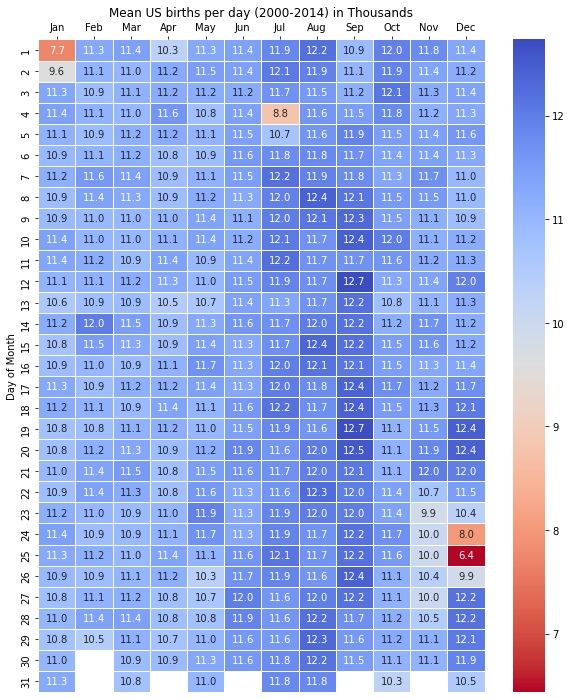So February 31st is exactly average?
Cool Guides
Rules for Posting Guides on Our Community
1. Defining a Guide Guides are comprehensive reference materials, how-tos, or comparison tables. A guide must be well-organized both in content and layout. Information should be easily accessible without unnecessary navigation. Guides can include flowcharts, step-by-step instructions, or visual references that compare different elements side by side.
2. Infographic Guidelines Infographics are permitted if they are educational and informative. They should aim to convey complex information visually and clearly. However, infographics that primarily serve as visual essays without structured guidance will be subject to removal.
3. Grey Area Moderators may use discretion when deciding to remove posts. If in doubt, message us or use downvotes for content you find inappropriate.
4. Source Attribution If you know the original source of a guide, share it in the comments to credit the creators.
5. Diverse Content To keep our community engaging, avoid saturating the feed with similar topics. Excessive posts on a single topic may be moderated to maintain diversity.
6. Verify in Comments Always check the comments for additional insights or corrections. Moderators rely on community expertise for accuracy.
Community Guidelines
-
Direct Image Links Only Only direct links to .png, .jpg, and .jpeg image formats are permitted.
-
Educational Infographics Only Infographics must aim to educate and inform with structured content. Purely narrative or non-informative infographics may be removed.
-
Serious Guides Only Nonserious or comedy-based guides will be removed.
-
No Harmful Content Guides promoting dangerous or harmful activities/materials will be removed. This includes content intended to cause harm to others.
By following these rules, we can maintain a diverse and informative community. If you have any questions or concerns, feel free to reach out to the moderators. Thank you for contributing responsibly!
That is a fucking screenshot
Also discovered something crazy about birthdays when it comes to athletics and competitive sports.
An athletes chance of success are based on what month they are born. Depending on the sport, region and organizations and systems involved ... if an athlete is born earlier in the year and the rank they are placed in starts at the beginning of the year, they have a better chance because they will almost be a year older than the player born at the end of the year. In Junior leagues or youth divisions at 10 years of age to 18 ... a year makes a huge difference in the players.
I learned all of this from talking to a few individuals who went through provincial level hockey in Ontario.
When it comes to the top level sports ... what month you are born really matters.
This matters in education too. Malcolm Gladwell did a bit of a study on it.
Makes sense though. In anything that is segregated by year, the oldest in one cohort is going to have nearly a full year more development than the youngest.
With 8 billion people alive I refuse to believe there is any statistical difference between days of the year. For example according to this infographic my birthday is one of the most common but the days before and after are not?
It makes sense to pop your sprogs in spring and summer when food is more available.
September births are more common because of christmas sex
Here is a more believable chart, covering 62,187,024 US births (2000-2014) based on Social Security Administration's data. The scale is not completely arbitrary on this one.

Meanwhile, the post's chart actual Reddit OOP is u/plotset, an account made to shill PlotSet.com, a data visualization software.
They had this to say about the data:
This data represents 4,153,303 US-born babies only between 2000 and 2014.
Top 10 Most Common: Sep 12 (0.307%) Sep 19 (0.306%), Sep 20 (0.302%), Dec 19 (0.300%), Sep 10 (0.300%), Dec 20 (0.299%),Sep 18 (0.299%), Aug 8 (0.299%), Sep 26 (0.299%), Sep 17 (0.298%)
Top 10 Least Common: Dec 25 (0.155%), Jan 1 (0.186%), Dec 24 (0.193%), Jul 4 (0.212%), Jan 2 (0.231%), Dec 26 (0.238%), Nov 23 (0.238%), Nov 25 (0.240%), Nov 27 (0.241%), Nov 24 (0.241%)
Data Source: Kaggle.com/datasets/ayessa/birthday
Tools: PlotSet.com
Note that the "4,153,303" figure is bullshit. It is close to births per year but does not actually correspond to the sum in any of the 15 years, nor the average.
So it is about average for almost all days. You have more births in fall, probably because of more sex in winter.
And it seems woman really don't want to birth on important holidays. I didn't think that the power of will is that strong.
It's not, but the power of scheduling a c-section so that you don't spend Christmas at the hospital is.
Don't forget the weekdays. The total births in the dataset by weekday are:
SUN |||||||||||||||||||||||| 5886889
MON ||||||||||||||||||||||||||||||||||||| 9316001
TUE ||||||||||||||||||||||||||||||||||||||||| 10274874
WED |||||||||||||||||||||||||||||||||||||||| 10109130
THU |||||||||||||||||||||||||||||||||||||||| 10045436
FRI ||||||||||||||||||||||||||||||||||||||| 9850199
SAT |||||||||||||||||||||||||| 6704495
This absolutely varies by country/culture, not drastically, but you will see different patterns
The high period before/after Christmas so that more of the medical community can have Christmas off is pretty strong.
I have no idea why August has such a strong weekly cycle, when July/September aren't that clear. I mean... surely weekend vs. weekday is canceled out by having multiple years that people are born in. If someone knows, I'd love to hear the answer.
The color scale hugely amplifies minor differences, see my other comment. In the dataset, 15 years (2000-2014) are represented and the weekly cycle is therefore present. This could have been mitigated by using a 28-year dataset. Here is how often each month started on a given day in the dataset. We don't have colored text so I used emoji.
| 01/ | JAN | FEB | MAR | APR | MAY | JUN | JUL | AUG | SEP | OCT | NOV | DEC |
|---|---|---|---|---|---|---|---|---|---|---|---|---|
| SUN | 2➖ | 2➖ | 1🔻 | 3⚠️ | 2➖ | 3⚠️ | 3⚠️ | 2➖ | 2➖ | 2➖ | 1🔻 | 2➖ |
| MON | 2➖ | 1🔻 | 2➖ | 2➖ | 2➖ | 1🔻 | 2➖ | 2➖ | 3⚠️ | 3⚠️ | 2➖ | 3⚠️ |
| TUE | 3⚠️ | 3⚠️ | 2➖ | 3⚠️ | 3⚠️ | 2➖ | 3⚠️ | 2➖ | 1🔻 | 2➖ | 2➖ | 1🔻 |
| WED | 2➖ | 2➖ | 2➖ | 1🔻 | 2➖ | 2➖ | 1🔻 | 3⚠️ | 2➖ | 3⚠️ | 2➖ | 2➖ |
| THU | 2➖ | 2➖ | 3⚠️ | 2➖ | 3⚠️ | 2➖ | 2➖ | 2➖ | 2➖ | 1🔻 | 3⚠️ | 2➖ |
| FRI | 1🔻 | 3⚠️ | 2➖ | 2➖ | 1🔻 | 3⚠️ | 2➖ | 3⚠️ | 2➖ | 2➖ | 2➖ | 2➖ |
| SAT | 3⚠️ | 2➖ | 3⚠️ | 2➖ | 2➖ | 2➖ | 2➖ | 1🔻 | 3⚠️ | 2➖ | 3⚠️ | 3⚠️ |
It surprises me that there are a lot of births on valentine's day.
Like 9 months later? Sure. But this? Nah.
For Christmas it makes sense because it saves a lot of money
Also interesting to see how few births there are Christmas.
"Can you hold it in just two more days, honey? Don't wanna ruin this year's celebration."
Hospital staffing and delivery management are more likely the causes. If the risk is low, they're less likely to start an induction on those days.
I garantee you it's crazy people planning their sexy time accordingly and then pushing for a c-section cuz it's romantic
Now let's look at holidays 40 weeks prior...
Yeah, everybody's parents are fuckin between Thanksgiving and New Years.
Anecdotally, I knew that years ago. I worked in a call center and got so bored that I'd mark the day in my yearly calendar when a customer had that birthday, and September and August filled up quick and had so many duplicates. Took me forever to fill up winter, though.
Don't forget Valentine's day.
Do you mean for the sex or giving birth? For the former, I'm guessing that's why there's a bump in December. For the latter, I wouldn't be surprised if people made extra effort to give birth on valentine's day. Plus, sex can induce labor if you're close.
